
Roy Fox Lichtenstein was an American pop artist. During the 1960's, along with Andy Warhol, Jasper Johns, and James Rosenquist, he became a leading figure in the new art movement. His work defined the premise of pop art through parody. Inspired by the comic strip, Lichtenstein produced precise compositions that documented while they parodied, often in a tongue-in-cheek manner. His work was influenced by popular advertising and the comic book style. His artwork was considered to be "disruptive". He described pop art as "not 'American' painting but actually industrial painting". His paintings were exhibited at the Leo Castelli Gallery in New York City.
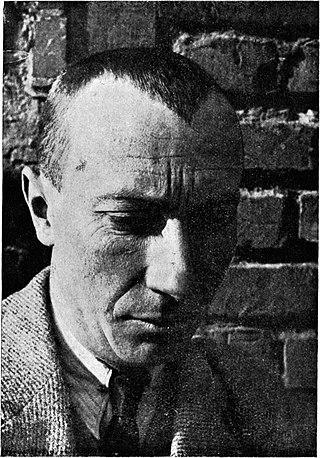
Hans Peter Wilhelm Arp, better known as Jean Arp in English, was a German-French sculptor, painter and poet. He was known as a Dadaist and an abstract artist.

The National Gallery of Art is an art museum in Washington, D.C., United States, located on the National Mall, between 3rd and 9th Streets, at Constitution Avenue NW. Open to the public and free of charge, the museum was privately established in 1937 for the American people by a joint resolution of the United States Congress. Andrew W. Mellon donated a substantial art collection and funds for construction. The core collection includes major works of art donated by Paul Mellon, Ailsa Mellon Bruce, Lessing J. Rosenwald, Samuel Henry Kress, Rush Harrison Kress, Peter Arrell Browne Widener, Joseph E. Widener, and Chester Dale. The Gallery's collection of paintings, drawings, prints, photographs, sculpture, medals, and decorative arts traces the development of Western art from the Middle Ages to the present, including the only painting by Leonardo da Vinci in the Americas and the largest mobile created by Alexander Calder.

George Warren Rickey was an American kinetic sculptor.
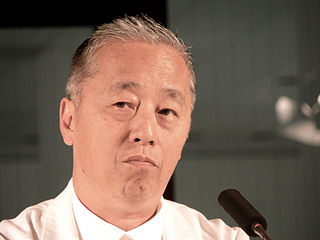
Hiroshi Sugimoto is a Japanese photographer and architect. He leads the Tokyo-based architectural firm New Material Research Laboratory.

The Des Moines Art Center is an art museum with an extensive collection of paintings, sculpture, modern art and mixed media. It was established in 1948 in Des Moines, Iowa.

Sir Roy Colin Strong, is an English art historian, museum curator, writer, broadcaster and landscape designer. He has served as director of both the National Portrait Gallery and the Victoria and Albert Museum in London. Strong was knighted in 1982.
Bernard Gerald Cantor was the founder and chairman of securities firm Cantor Fitzgerald.

The National Gallery of Art Sculpture Garden is the most recent addition to the National Gallery of Art in Washington, D.C. in the United States. It is located in the National Mall between the National Gallery's West Building and the Smithsonian Institution's National Museum of Natural History.

The Beyeler Foundation or Fondation Beyeler, with its museum in Riehen, near Basel (Switzerland), owns and oversees the art collection of Hildy and Ernst Beyeler, which features modern and traditional art. The Beyeler Foundation museum includes a space for special exhibitions staged to complement the permanent collection. In 2006, approximately 340,000 persons visited the museum. The number of visitors in 2016 was 332,000. The Beyeler Foundation is the most visited museum of art in all of Switzerland. The museum is properly funded, and it receives annual grants from the cantons of Basel City and Basel County and the commune of Riehen. Major partners of the Foundation are Bayer AG, Novartis and Swiss bank UBS.
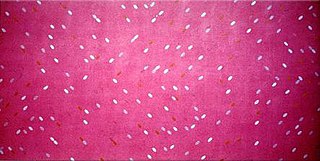
Lawrence M. "Larry" Poons is an American abstract painter. Poons was born in Tokyo, Japan, and studied from 1955 to 1957 at the New England Conservatory of Music, with the intent of becoming a professional musician. After seeing Barnett Newman's exhibition at French and Company in 1959, he gave up musical composition and enrolled at the School of the Museum of Fine Arts, Boston. He also studied at the Art Students League of New York. Poons taught at The Art Students League from 1966 to 1970 and currently teaches at the League.
The Frederick R. Weisman Art Foundation is a non-profit arts foundation located on North Carolwood Drive in the Holmby Hills district of Los Angeles, California. Modern and contemporary artwork in the Frederick R. Weisman collection are displayed in a "living with art—house museum" context, with guided public tours by appointment with the foundation.
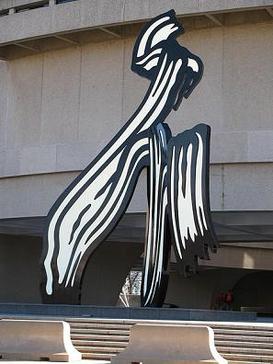
Brushstroke is a sculpture by Roy Lichtenstein. There are two copies. The original was created in 2001 for the Museo Nacional Centro de Arte Reina Sofía in Madrid, Spain. The second was delivered to the Hirshhorn Museum and Sculpture Garden in Washington, DC, on September 16, 2003, and dedicated on October 25, 2003.
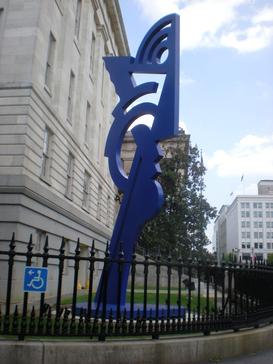
Modern Head is the name given to five extant 31-foot tall steel sculptures by Roy Lichtenstein. It has sometimes been claimed that the artist produced Modern Head as an edition of four sculptures; however, this is incorrect.

Grrrrrrrrrrr!! is a 1965 oil and Magna on canvas painting by Roy Lichtenstein. Measuring 68 in × 56.125 in, it was bequeathed to the Solomon R. Guggenheim Museum collection from Lichtenstein's estate. It depicts a head-on representation of an angry dog growling with the onomatopoeic expression "Grrrrrrrrrrr!!". The work was derived from Our Fighting Forces, which also served as the source for other military dog paintwork by Lichtenstein.

Look Mickey is a 1961 oil on canvas painting by Roy Lichtenstein. Widely regarded as the bridge between his abstract expressionism and pop art works, it is notable for its ironic humor and aesthetic value as well as being the first example of the artist's employment of Ben-Day dots, speech balloons and comic imagery as a source for a painting. The painting was bequeathed to the Washington, D.C., National Gallery of Art upon Lichtenstein's death.
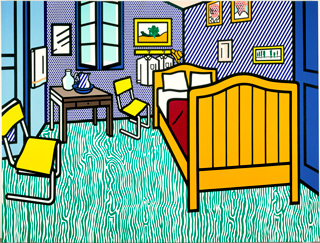
Bedroom at Arles is a 1992 oil and Magna on canvas painting by Roy Lichtenstein based on the Bedroom in Arles series of paintings by Vincent van Gogh. He painted it in July 1992. It is the only quotation of another painting that Lichtenstein did of an interior. It is located on the Fitzhugh Farm in Maryland in the Robert and Jane Meyerhoff Collection.
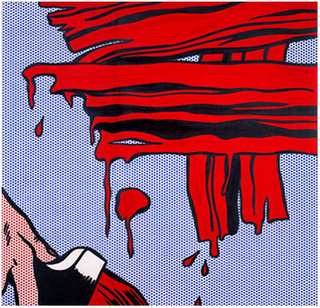
Brushstrokes series is the name for a series of paintings produced in 1965-1966 by Roy Lichtenstein. It also refers to derivative sculptural representations of these paintings that were first made in the 1980s. In the series, the theme is art as a subject, but rather than reproduce masterpieces as he had starting in 1962, Lichtenstein depicted the gestural expressions of the painting brushstroke itself. The works in this series are linked to those produced by artists who use the gestural painting style of abstract expressionism made famous by Jackson Pollock, but differ from them due to their mechanically produced appearance. The series is considered a satire or parody of gestural painting by both Lichtenstein and his critics. After 1966, Lichtenstein incorporated this series into later motifs and themes of his work.

The House series was produced by Roy Lichtenstein in the late 1990s and consists of several large-scale outdoor sculptures and an interior wall piece. The House series includes three distinct works: House I, House II, and House III. Each piece depicts the exterior of a simplified cartoon house, while actively producing an optical illusion. Houses I and III are available for display at the National Gallery of Art Sculpture Garden in Washington, D.C., and the High Museum of Art in Atlanta, GA, respectively. No records indicate the current location of House II.

The Met Fifth Avenue is the primary museum building for the Metropolitan Museum of Art in New York City. The building is located at 1000 Fifth Avenue, along the Museum Mile on the eastern edge of Central Park in Manhattan's Upper East Side.

















